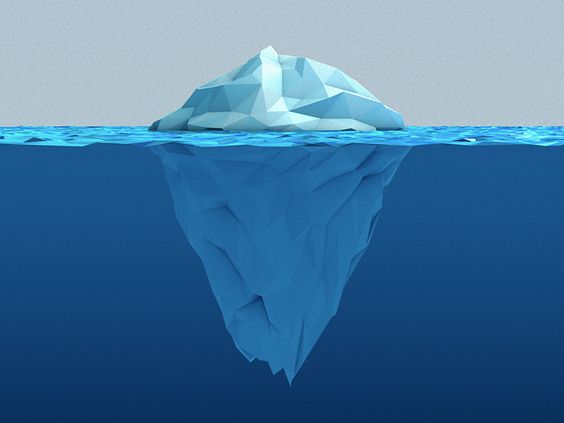As a teacher of conscious awareness and self-awareness I teach people how to expand their level of consciousness.
Consciousness is still a highly debated concept and many books, articles and research papers speak about how difficult it is to grow in consciousness and that it takes a long time. From my experience and from what I teach, anyone can learn how to develop their self-awareness and raise their level of consciousness in a fairly short time.
A key to this development is engaging your unconscious to become more conscious.
The best demonstration of the conscious and unconscious is the picture of the iceberg. With the conscious mind visible above the water and the unconscious mind, that makes up the massive bulk of the iceberg, lying invisible and unseen below the surface of the water. Memories, thoughts, feelings, and information that are too painful, embarrassing, shameful, or distressing for the conscious awareness, as well as early childhood programming on how to survive and remain safe, is all stored in the enormous reservoir that makes up the unconscious mind. You will notice that there is more unconscious content then conscious content. The levels of conscious and unconscious are different for everyone, which is why we each live our lives with different degrees of consciousness, some people are more conscious than other people.
To increase your level of consciousness requires that you bring more information from the unconscious level to the conscious level, so more ice becomes visible above the water, a metaphor for more of the true you being present in the world and therefore known and available to you.
Consciousness, many have argued, is what separates humans from other animals. Consciousness refers to our awareness of our own mental processes, such as our thoughts, feelings, and sensations. It is possible that we are the only beings on this planet that have this type of self awareness or level of consciousness and the ability to introspect, or look inward and examine these processes. For example, if you are angry, you can try to understand your anger, why you are angry, what that anger feels like, etc.
How do you do that:
1. Sleep is the most natural way and effortless way. While you sleep you spend time in REM sleep, which is when you dream and the body repairs and regrows tissues, builds bone and muscle, and strengthens the immune system. Freud believed that dreams reflected unconscious experiences, wishes and desires of the individual. Like Freud, Carl Jung also believed that dreams were a window to the unconscious mind and were filled with hidden meanings. He believed that dreams could be classified according to two categories, objective and subjective. Objective dreams were a picture of the individual’s day-to-day life. Subjective dreams reflected the individual’s inner life or unconscious world. Rosalind Cartwright, another dream expert, believes that dreams are the body’s way of reviewing, revising, rehearsing, and repairing present and past experiences.
Sleep gives us our unconscious the opportunity to surface to the conscious as a transfer of information.
2. Purposefully visiting your unconscious mind is the most effective way. We can visit our unconscious mind through static meditation or through dynamic meditation?
Traditional meditation is what most of us think of when we think of meditation. Remaining static and still: sitting on the floor, cross-legged with candles around us in a quiet place. We sit still, we quiet the mind and we meditate. In the quietness we are able to hear the unconscious mind. This is a beautiful form of meditation and originates from the Eastern cultures where they are comfortable with this type of meditation. The western world is challenged with this type of meditation as we sit on chairs, our minds never stop chattering and life is very busy. Dynamic meditation is more suitable to western cultures where we sit down on a chair, we stand, we walk and we move the body in the meditation.
I like to use the metaphor of the mother and child to demonstrate how each type of meditation works. Mother wants to get on with her work or a task, the child wants her attention, so the child continuously talks, demands and maybe even screams to get attention. Anyone who has dealt with an attention seeking child knows that you have 2 choices:
(1) ask the child to be quiet – good luck with that!
(2) occupy the child with a task such as colouring or a toy.
Traditional meditation asks the chatty mind to be quiet and dynamic meditation occupies the left-hemisphere of the mind, the chatty mind with tasks, so we can spend time with and hear the unconscious. What sort of tasks? We ask the mind to identify important information like sensations in the body, the sensation of gravity, weight, and temperature for example.
Both types of meditation are equally successful as long as we are able to spend time with the unconscious, by spending time in what we call the meditative/Sophro-liminal level.
In the Sophro-liminal level, the level between awake and asleep, we are able to communicate with and listen to the unconscious. In this way we can create clarity in our life, make changes to our beliefs, attitudes, triggers and fears. We can also deal with the unpleasantness of our past and allow the rising of information from the unconscious to the conscious that is required to support a happier and healthier life.
In conclusion, if you want to increase your level of consciousness, spend more time in the sophro-liminal level with your unconscious. There is no easier way than through our Sophro-kiⓇ or Conscious Awareness Training that is very flexible and easy to practice since you can do the dynamic meditation exercises anytime and when you are anywhere. Working with your unconscious to become increasingly more conscious and living your life consciously becomes an integral part of your everyday life.
Add Sophrology to your life and career!
Sophrology is a great addition to anyone looking to enhance their offer, such as teachers, medical profession (doctors, nurses, midwives, psychologists), Coaches, Counsellors, HR, wellbeing professionals, sport coaches and professionals and anyone interested in personal development through greater consciousness.
Contact Diana Ritchie to learn more about how to integrate consciousness into your everyday.
Also visit http://www.sophrologycenteronline.com/diploma-course/ to see our Sophro-ki® Sophrology training program.

